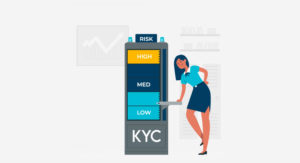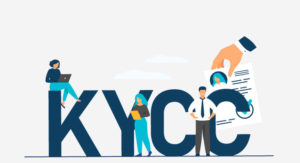Enhanced Due Diligence: How Important is it for Banks?

In today’s business and regulatory climate, a business has to take all precautionary steps to prevent fraud. This means identifying and verifying customers’ identities and meeting KYC guidelines. Whenever a financial institution starts a new business partnership with individuals or organizations without fully knowing their past and present business dealings, it can open the business to huge lawsuits and fines. EDD (Enhanced Due Diligence) can help businesses understand their customers.
As a matter of fact, over the last decade, over $26 billion in fines have been imposed across the U.S., Europe, APAC, and the Middle East against financial institutions for KYC/AML. But KYC compliance goes beyond ticking some checkboxes. KYC helps financial institutions understand and serve their customers in a better way.
The KYC process is often carried out by financial institutions while opening new accounts with online users. Customer Due Diligence (CDD) is a vital part of KYC verification, which usually involves background checks to assess the risk they pose to a business. In the financial sector, this usually involves verifying the users for creditworthiness and ensuring that these people aren’t on a money laundering or counter-terrorism financing watchlist.
Fortunately, most of these verifications and AML verification processes are becoming automated so businesses can offer a better customer experience during onboarding. With Customer Due Diligence (CDD) financial institutions perform important checks.
What is Enhanced Due Diligence?
(EDD) Enhanced Due Diligence is part of the KYC verification process that offers a greater level of scrutiny of potential business partnerships and highlights risks that can’t be detected by customer due diligence. Enhanced due diligence requirements are an upgraded version of CDD that looks to establish a better level of identity verification by using customer ID data and evaluating the risk category of the customer.
EDD is specifically designed for dealing with high-risk customers and large transactions. These customers and the transactions they conduct pose greater risks to the financial sector, these customers and transactions are continuously monitored to ensure that nothing is out of place.
There are several characteristics that EDD from regular KYC policies:
- Rigorous & Robust: EDD policies have to be rigorous and more robust and should require more data for customer authentication.
- Detailed Documentation: The EDD process has to be documented in detail, and regulators should be able to have immediate access to enhanced due diligence reports.
- Reasonable Assurance: EDD requirements require “reasonable assurance” while building a risk profile.
- Going Through PEPs: Banks and financial institutions need to pay attention to Politically Exposed Persons (PEPs) lists. People on these lists are viewed as being a higher risk because they are in positions that can be exploited for money laundering.
Another major challenge with EDD is knowing how much information is there to collect. Regulators have consistently favored financial institutions that leverage documented policies & procedures.
More and more companies are combining online identity verification and automated AML screening during the account onboarding process.
KYC Factors for Enhanced Due Diligence
To make sure your enhanced due diligence process is on-point, you need to pay attention to a number of factors.
These factors include:
- Location of the business/individual.
- Purpose of the business transactions.
- Occupation and nature of the business.
- The pattern of activity (transaction type, dollar volume, and frequency).
- Expected origination of payments and method of payment.
- Document of incorporation, partnerships, and business certificates.
- Understanding the customer base.
- Ultimate Beneficial Owner Verification.
- Information about personal and business relationships.
- AML policies are set by the business in place.
- Third-party documentation.
- Reputation in the local market.
There are some cases that demand EDD verification. In Europe, banks and financial institutions are required to conduct EDD for businesses operating in high-risk countries.
The requirement also calls for EDD of Politically Exposed Persons. The new 6AMLD compliance has put additional pressure on financial institutions to conduct more vigorous verification. Negligence or non-compliance can lead to hefty fines.
This pressure has only increased after sanctions on Russian Companies. Banks and financial institutions have to be extra careful about who they onboard.
In April 2022, the Office of the Comptroller of the Currency put additional light on the need for thorough EDD policies. These include:
- Maintaining an accurate and complete list of sanctioned companies and high-risk counties.
- Evidence of transactions, which includes unexpected activities, and unexpected sources of funds.
- Complete analysis of available information. Including red flags in information and making a document of high-risk indicators and suspicious activities.
Enhanced Due Diligence Checklist
So, what do banks and financial institutions get out of using EDD as part of their KYC verification process? Here’s the Enhanced due diligence checklist:
1. Better Serve Your Customers
The EDD and identity verification process offer a bunch of useful information regarding your customers, including employment status, age, and so on. This data can be used to provide customers with better services.
2. Enhance Brand Reputation
Whenever a bank, or financial institution onboards a new customer with EDD, they can help in the prevention of corrupt politicians, criminals, and terrorists from entering the ecosystem. This also means that taking precautions to know your customer at a more fundamental level.
Businesses need to build robust safeguards that help in defending against losses for fraud, non-compliance fines, and loss of brand reputation.
All the ideas of knowing your customers, verifying identities, making sure they’re real, and cross-referencing customers from PEPs and Sanction lists. Enhanced due diligence and other fraud prevention methods such as bank account verification software allow businesses to focus on scaling their businesses instead.
4. Build Trust
Unfortunately, as more and more cases of data breaches, money laundering, and financial fraud are being uncovered, customers are losing trust in the banking sector. It is high time for banks, financial institutions, payment providers, and others to stop the flow of money laundering and other financial crimes.
This can happen by integrating identity verification and identity screening technologies into the KYC workflow. With a secure digital-first approach, it is possible for banks to digitally onboard customers from all over the world. While ensuring security and enhancing a positive customer experience.
Measures for Enhanced Due Diligence
Let’s say there’s a client that needs EDD verification, what will you do? Instead of going through the process without proper knowledge, you can take some measures. A lot of financial institutions follow de-risking strategies, but that’s too much hassle for legit companies.
The FATF recommends following a risk-based approach for high-risk customers. In a risk-based approach, the amount of information required increases when the level of risk associated with the business increases.
The risk-based approach offers several other advantages for financial institutions. Entities can scale it up or down based on the size and scale of the business. It is highly flexible and can adapt to changing conditions, technology, and other factors.
According to FATF, financial institutions must follow some particular steps while conducting EDD, such as:
- Institutions should try to gather as much information as possible about a customer. They should use this information to build an ideal risk assessment profile.
- Should conduct additional searches to get more information about individual customer risk assessment.
- Should build a thorough report on the customer or beneficial owner to better understand the level of risk involved. It is possible that the beneficial owner is part of criminal activities.
- Institutions should build a number of questions that help them collect additional information about the customer. The questions should also try and uncover the intended nature of the business relationships.
Also, it’s not enough to run checks just once, EDD is an ongoing process. To make sure banks stay on top of all the risky activities, they need to keep track of high-risk customer activities.
Requirements for Beneficial Owner EDD
To make sure that you’re covering all the bases, you need to verify the identity of the beneficial owner. Often, institutions forget or neglect the need to verify the beneficial owner. This can put them at greater risk of financial crime.
UBO verification is slowly becoming a vital part of EDD. If an account holder does some international transactions, institutions need to know the beneficial owners of the other account holder. This is to comply with the OFAC (Office of Foreign Assets Control). The OFAC requires banks to conduct due diligence of international accounts at the time of transaction.
Due to the FCPA ACT, an institution has to identify the owner of all the third-party intermediaries. A company can’t comply with regulations properly until they thoroughly check the beneficial owner information.
The 4AMLD states that all the member states have to ensure that all the entities are incorporated within their territory according to national law. They need to collect all the vital information about the beneficial ownership alongside all the basic information about the entity itself.
In the US, there are similar beneficial ownership disclosures that are a part of the FinCEN Customer Due Diligence Final Rule. As per the FinCEN Guidance FIN-2016-G003, “the CDD Rule outlines explicit customer due diligence requirements and imposes a new requirement for these financial institutions to identify and verify the identity of beneficial owners of legal entity customers, subject to certain exclusions and exemptions.”
The FATF did an analysis of the beneficial ownership best practices, and they concluded that the challenges with tracing UBO information while dealing with foreign ownership or directorships suggest the requirement for enhanced measures for these entities.
Procedure for Ultimate Beneficial Ownership Verification
Up until a couple of years ago, verifying beneficial ownership was a challenging and cumbersome process. It included a lot of manual work which led to mistakes. Business entities had to submit official documents to financial institutions.
Businesses that had to go through additional due diligence have to provide other documents based on their level of risk.
Some common examples include:
- Official company documents from the official registry to verify information submitted by the account holders.
- UBO identification and verification.
- Performing KYC checks on ultimate beneficial owners.
With the help of DIRO’s ultimate beneficial ownership verification, financial institutions can now say goodbye to old manual methods.
DIRO can instantly verify incorporation documents with automated user consent in over 195 countries. It helps in eliminating fraud in merchant onboarding and complying with vendor due diligence rules. Moreover, banks can use it for UBO identity verification and cut down on the risk of UBO fraud.
Conclusion – Growing Need for EDD
Changing regulations and policies are increasing the need for enhanced due diligence. As the scope and need for due diligence requirements are growing, the need for technologies that can handle these requirements is also growing. DIRO document verification and KYC verification solution can help institutions stay on top of these changing requirements with instant and accurate document verification.













